
Byron Scott recently opened up about his time with the Los Angeles Lakers, shedding light on the unique dynamics that defined the franchise during the height of its success. One of the more intriguing aspects he discussed was the role of legendary filmmaker Jack Nicholson, who has long been a prominent figure at Lakers games. Scott revealed that Pat Riley, the iconic coach of the Lakers during the 1980s and early 90s, played a significant part in integrating Nicholson into the team’s inner circle.
Jack Nicholson’s connection to the Lakers goes beyond mere fandom. With his charismatic presence, he became a staple in the front row of the Staples Center, cheering on the team with unbridled enthusiasm. His courtside antics and celebrity status contributed to the Lakers’ image, creating a buzz around the team that extended beyond the basketball court. Nicholson’s passion for the game and the team mirrored that of many fans, but his unique position as a Hollywood icon allowed him to forge relationships with players and coaches alike.
Byron Scott, who played for the Lakers from 1983 to 1993 and later returned as head coach, shared that Pat Riley was instrumental in fostering this special relationship. According to Scott, Riley recognized the value of having such a high-profile supporter as Nicholson. Not only did it add to the Lakers’ allure, but it also created a sense of camaraderie within the organization. Riley’s decision to include Nicholson in the team’s inner circle showcased his understanding of how celebrity culture could positively influence the franchise’s image and spirit.
Scott recounted specific instances where Nicholson would interact with players and coaches, becoming more than just a spectator. Nicholson’s presence during crucial games and practices created an atmosphere of excitement and prestige. Scott noted that Nicholson would often offer encouragement and praise, further motivating the players during tense moments. This connection contributed to a sense of unity and purpose within the team, as players felt they were part of something larger than just basketball.
The relationship between Nicholson and the Lakers exemplifies how sports and entertainment often intertwine. Nicholson’s influence extended beyond mere attendance; he embodied the vibrant culture surrounding the team. His celebrity status drew attention to the Lakers, helping to elevate the franchise’s profile both nationally and internationally. The Lakers were not just a basketball team; they became a cultural phenomenon, and Nicholson was an integral part of that narrative.
Riley’s strategic decision to embrace Nicholson reflects his broader approach to coaching and team building. He understood that creating a winning culture went beyond X’s and O’s; it involved cultivating relationships that fostered teamwork and resilience. By welcoming Nicholson into the inner circle, Riley not only enhanced the team’s public image but also provided players with a unique experience that transcended the sport. Nicholson’s presence served as a reminder that success in the NBA often involved an interplay between performance on the court and the broader cultural context surrounding the game.
Moreover, Scott emphasized that Nicholson’s engagement with the Lakers extended to celebrations and victories. When the team triumphed, Nicholson was often there to join in the festivities, further solidifying his status as an honorary member of the Lakers family. His genuine love for the game and the franchise added a layer of authenticity that resonated with both players and fans. This connection created a tight-knit community, where players felt supported not just by their teammates but also by a larger network that included figures like Nicholson.
In discussing this dynamic, Scott acknowledged the pressures players face in high-stakes environments. Having a celebrity like Nicholson around offered a unique perspective, reminding players that, while basketball is a serious endeavor, it can also be a source of joy and entertainment. Nicholson’s lighthearted approach to the game helped to ease some of the tension, allowing players to embrace the moment.
Byron Scott’s reflections on Jack Nicholson’s role in the Lakers’ inner circle highlight the multifaceted nature of professional sports. It’s a reminder that success is not solely determined by talent and strategy; it also involves understanding the cultural landscape and the relationships that can elevate a team. Pat Riley’s decision to welcome Nicholson illustrates the power of collaboration between sports and entertainment, ultimately enriching the Lakers’ legacy in the annals of basketball history.
In a world where celebrity culture often overshadows athletic achievement, the partnership between Nicholson and the Lakers remains a fascinating example of how these two realms can harmoniously coexist, driving the franchise to unprecedented heights.



Be the first to comment